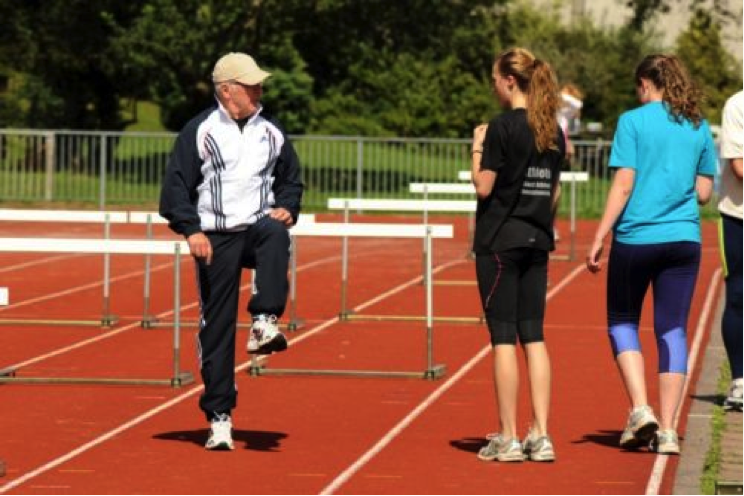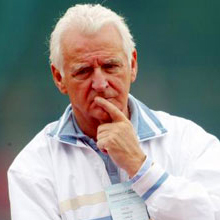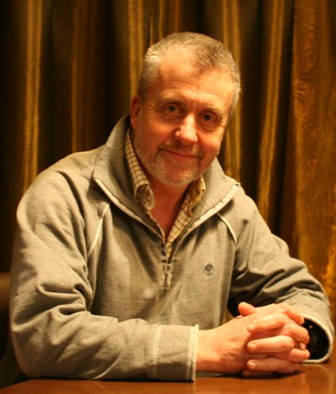John in Cornwall in 2011 with some young hurdlers
John Anderson who died on Sunday 28th July, 2024, aged 92, was a coaching legend in Britain. You can read our profile, which was written with his active co-operation, at this link. Writing his profile was an interesting experience in itself. Although I first met him in the early 1960’s when I was a young coach and he was SAAA National Coach travelling the length and breadth of Scotland encouraging athletes of all ages, teaching coaches and spotting talent. He was one of only two coaches in Britain who was a senior coach in every event on the athletics calendar and had, he told me, coached 147 British International athletes. When I phoned him about writing the profile, he was his typical enthusiastic self BUT – I had to telephone him on Monday at 1:00 pm. That was the only time he could speak to me. Except that after he spoke to me and I went out for the afternoon, I would return to a message from him on the telephone answering machine adding to or even correcting something he had said earlier in the morning. The same procedure every time that I phoned him. He added to almost everything he said to me to be sure I had it right or that I had all the information. One senior coach, a master coach no less, said to me at one point that he would never coach children or very young athletes again, he was past all that. Look at the picture above of John above, aged 79, with some young hurdlers. He’d never have said he was “past all that.”
Scottish athletics owed John a lot. Not just for his personal activities with athletes, coaches and clubs but also for some of the structures he put in place and also for the Scottish International Coaching Convention which was held annually in Edinburgh, an initiative kept going by a succession of coaches starting with Frank Dick, then carried on by Allan Jones and David Lease. Some of the best coaches and specialists in the world came to Scotland and talked to the coaches. We have several of them commenting on their thoughts and interactions with John since they heard the news on Sunday. There were many who would say with Hugh Barrow, former Scottish and British international athlete, when he said he vividly remembered “Mini bus trips to Cosford John at the wheel with Doug Edmunds at the front as ballast and Moira Kerr at the back on guitar singing the Wild Side of Life hammering over Shap”. We start with Frank Dick who succeeded John as Scottish National Coach and is a very highly qualified coach in his own right, having worked with sportsmen across many disciplines.
I really got to know John after he invited me to coach at Scottish Schools Easter courses. I was still at Loughborough and hungry to learn from him. So when He asked me to join his staff it was a no brainer. While it was great to work with Scotland’s next generation of National Athletes and learn through that experience the greatest learning was in the evenings. Debate and discussion went into the early hours every night. Alex Naylor, Eddie Taylor, Davie Morrison all got involved but John was at the centre, steering thinking in one direction or another. On several occasions you would be arguing A and John B. Two hours later it was the other way round.
So first picture of him was someone who would challenge you to think differently. Next picture was of someone who truly understood pedagogics and principles of training that were at core of Jordanhill’s Physical Education course. He was relentless in his focus on basics. It was no accident that Jordanhill produced two outstanding National Athletics coaches in UK, in John and Tom McNab. They founded their coaching on brilliant teaching – a Jordanhill trademark.
Next picture is really a blending of the first two. He made time to share his experience and expertise. So he was as much a coach of coaches as of athletes.
Finally, there is a picture of a coach with extraordinary adaptability to coach across the full range of athletics events. Very few coaches can do this. It is quite a sophisticated competence to balance what is generic and what is specific when applying your coaching skills. It’s this picture that defines just how world class he was. Of course none of us is perfect and John’s intensity and passion whilst fuelling the energy that produced his incredible list of achievements, it could very occasionally create more heat than light. This however, served well to enrich my picture not only of the character he was but the immense depth of character he had.”
Hamish Telfer, and his friend Cameron McNeish, was coached as a young athlete by John and went on to become a GB coach himself and to be a sports historian, specialising in athletics history. He has this to say of the man.
“John Anderson is of course remembered for his outstanding coaching of those who he took to elite level but John also coached those whose abilities were more modest of which I was one. He demanded only one thing; hard work. There were many like me and this hopefully represents their views as well as my own. He had a profound influence on not only my life but others who had aspirations, and he changed my life to give it structure and meaning. I was lucky as I got to tell John that a few years back and was able to thank him. Uncompromising (often), argumentative (usually) but he responded to the loyalty shown to him with a loyalty to his athletes and he should also be remembered for a strong guiding influence on those he coached.
Memories have flooded in of the times in the 1960s. 20 second runs in snow storms at Grangemouth on Christmas eve; conditioning sessions at Springburn (where he once went off to answer a call and we simply kept going without a break until he came back 30minutes later); helping him splice his loop films at his house; helping him as an athlete ‘demonstrator’ on coaching courses and of course arriving at his house on my small ‘motorbike’ with hypothermia, conking out and waking up in front of his fire and then being told to get into the car as we had a training session to do. There was also the trip to RAF Cosford (as it was back then) for an indoor meeting when in thick fog he told me to open the back door, lean out and tell him where the white line in the road was (we were driving overnight and it was pre motorway days). Finally there are the ‘sayings’ … ‘I don’t feel any pain!’; ‘I’ll tell you when it hurts’, ‘Even when I’m wrong I’m still right’ and of course the easy smile and the quiet ‘well done’. I’m glad I got to tell him what he did for me and of course for all the others like me.”


